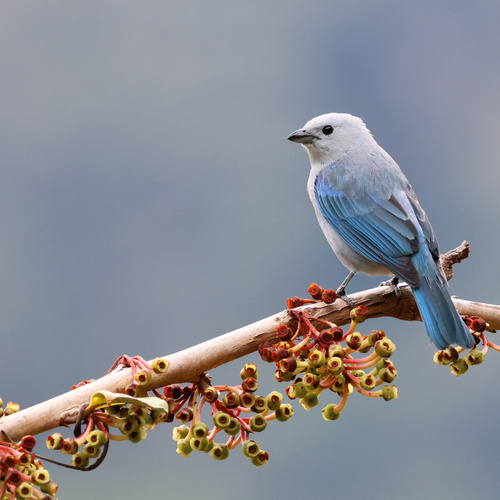
Blue-grey Tanager
The Blue-grey Tanager (*Thraupis episcopus*) is a vibrant and widespread Neotropical bird known for its striking blue-grey plumage. It plays a significant role in seed dispersal within its diverse range, contributing to forest regeneration. This species is a common sight in gardens and urban areas throughout much of Central and South America, making it a familiar and appreciated bird. It holds no particular prominent cultural significance beyond its general aesthetic appeal.
16-18 cm
Length
25-28 cm
Wingspan
Least Concern
Conservation Status
Distribution
The Blue-grey Tanager is found from southeastern Mexico south through Central America and across much of northern and central South America, as far south as Bolivia and northern Argentina. It has also been introduced to Lima, Peru. It does not typically engage in long-distance migrations, though some local movements may occur in response to food availability.
Lifespan
The typical lifespan in the wild is not well-documented, but likely around 5-10 years, based on similar tanager species.
Blue-grey Tanager's Habitat
Habitat Types
Forest edges, Woodlands, Gardens, Parks, Agricultural areas, Secondary growth
Climate Zones
Tropical, Subtropical
Adaptations
This species demonstrates adaptability to a wide range of habitats, including human-modified landscapes. Its varied diet allows it to thrive in areas where other, more specialized species might struggle.
Variations
There are over a dozen recognized subspecies of the Blue-grey Tanager, differing slightly in plumage coloration and size across their extensive range.
Appearance
Breeding Plumage
Plumage remains relatively consistent throughout the year.
Seasonal Feather Changes
Minimal seasonal variation.
Sex Based Plumage Differences
Males and females exhibit similar plumage, although males may have slightly brighter blue tones.
Notable Features
Predominantly blue-grey body plumage., Darker blue wings and tail., Some subspecies have a white or pale shoulder patch.
Diet and Feeding
Primary Foods
Fruits, Insects, Nectar
Foraging Behavior
Blue-grey Tanagers actively forage in trees and shrubs, often in pairs or small groups. They glean insects from leaves and branches and pluck small fruits.
Specializations
Their relatively generalized diet allows them to exploit a variety of food sources.
Seasonal Diet Variations
Diet may shift slightly depending on fruit and insect availability, with a greater reliance on fruit during fruiting seasons.
Behavior
Social Structure
Often found in pairs or small family groups. They may also join mixed-species foraging flocks.
Communication
High-pitched calls and whistles., A simple, somewhat buzzy song.
Migration
Generally non-migratory, but may undertake local movements in response to food availability.
Territorial or Group Behaviors
They can be territorial during the breeding season, defending their nesting area from other tanagers.
Conservation
Threats
Habitat loss due to deforestation (although adaptable), Pesticide use in agricultural areas
Protection Programs
General habitat conservation efforts benefit this species., Not specifically targeted by major conservation programs due to its 'Least Concern' status.
Local National Laws
Protected under general bird protection laws in many countries within its range.
Population Trend
Stable
Population Estimates
Widespread and common; global population estimates are not precise, but considered to be in the millions.
Interesting Facts
Blue-grey Tanagers are known for their adaptability to human-altered environments.
They are frequently seen in gardens and urban areas, taking advantage of fruit trees and bird feeders.
The scientific name *episcopus* means 'bishop' in Latin.
This refers to the blue-grey plumage, which was thought to resemble the robes of a bishop.
They are important seed dispersers.
By consuming fruits and later excreting the seeds in different locations, they help plants colonize new areas.
Faqs about Blue-grey Tanager
Are Blue-grey Tanagers good pets?
No, Blue-grey Tanagers are wild birds and are not suitable as pets. They require a specialized diet and environment and are protected by law in many areas.
What can I do to attract Blue-grey Tanagers to my garden?
Planting native fruit-bearing trees and shrubs, providing a source of fresh water, and avoiding the use of pesticides can help attract them.
Do Blue-grey Tanagers migrate?
They are generally non-migratory, but may make local movements in response to food availability.
Copyright @ Nature Style Limited. All Rights Reserved.
 English
English